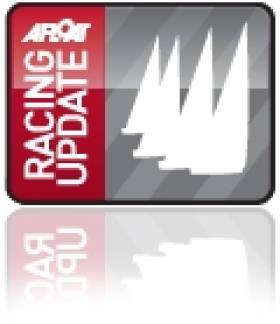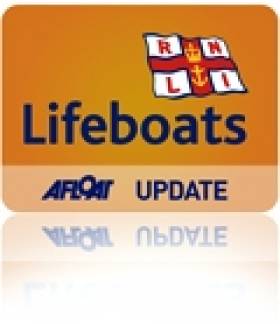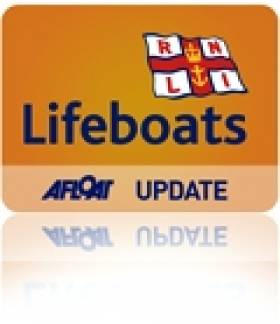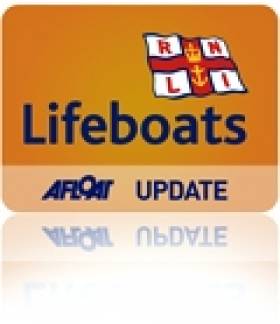Displaying items by tag: Lough Ree
#moth – The world's oldest one design dinghy combined with the world's fastest dinghy last weekend at Killinure on Lough Ree for an early season training and racing weekend.
The event started with a social nine holes of golf at the beautiful Glasson Golf Club on Friday evening! Sailing started on Saturday morning with a race in a cold 15-20kt blustery westerly for the seven Waterwags and six Moths from a start line at Quigleys Marina to the finish line at the Wineport Lodge.
The leading Moth Annalise Murphy covered the 2 mile long course in less than 5 minutes! Further races were held on the inner lakes below Glasson Golf Club before the usual excellent lunch in the Wineport and the return sail to Killinure.
After a combined class party in the Killinure Chalet Restaurant on Saturday night, six races were run in the lighter winds on Sunday.
As well as the Moths and Wags, another visitor to Quigleys last weekend was the 40ft Bantry Bay Longboat 'Siann Mhara' recently built by local volunteers in Banagher.
All in all, a great pre-season warm up for the sailors and quite a spectacle!
Photos below by Garrett Leech
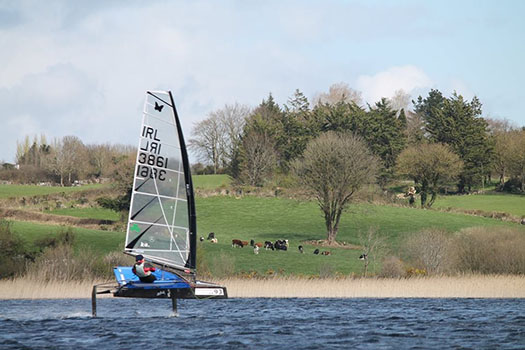


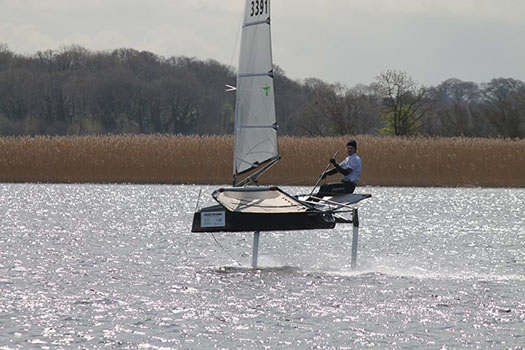
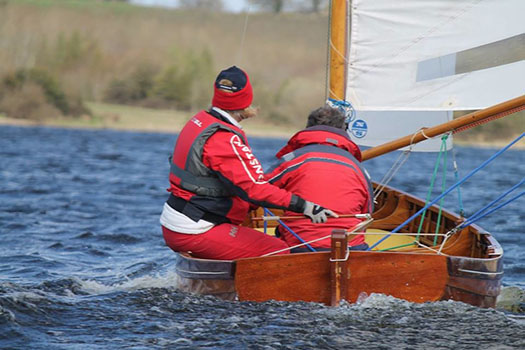
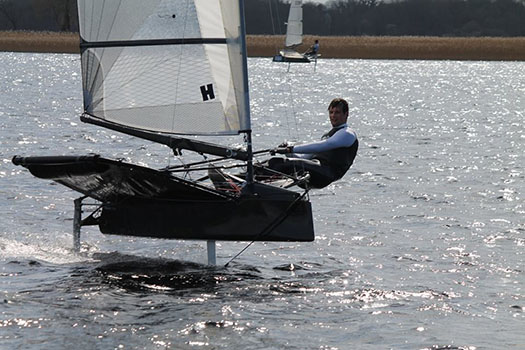
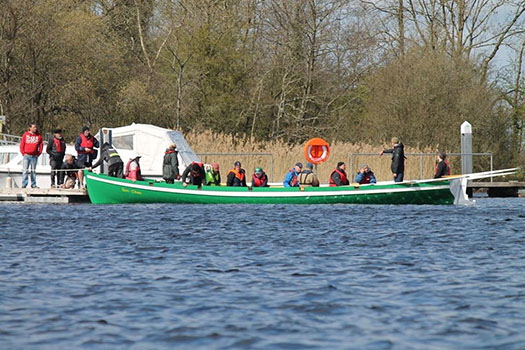
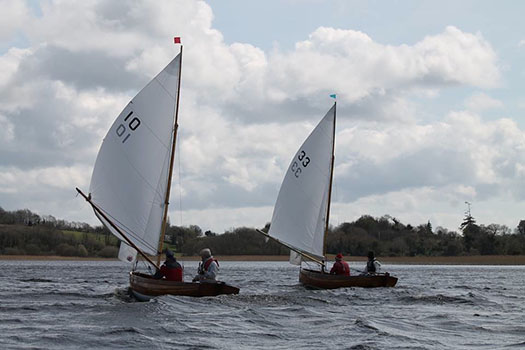
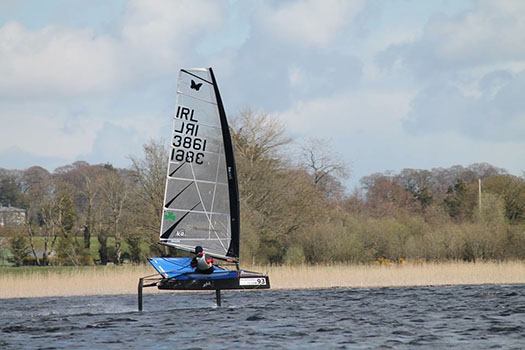


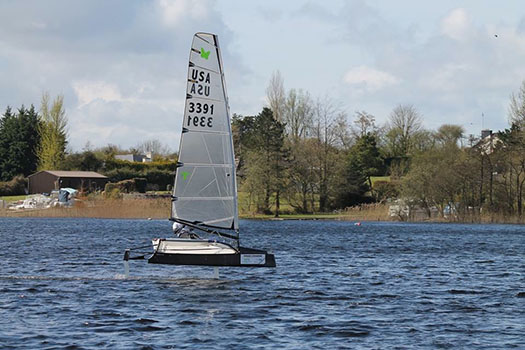
#OnTV - A boatbuilding project on the shores of Lough Ree will feature in a segment of tonight's Nationwide on RTÉ One from 7pm.
The 'Mens Shed' scheme for the Lanesborough-Ballyleague area – as part of a job activation and family support initiative for the twin towns – brought together 14 men to learn the craft of boatbuilding.
And the results are more than impressive, with the team building four new boats in just 25 days – a "huge success" in the words of Ballyleague-Lanesborough Area Mens Shed chairman Joe Cribbin
He hailed the scheme as preserving traditional arts and crafts for a new generation.
"On this occasion, as the lads continue their voluntary work in painting the boats, we would like to thank each and every person who supported this project in any way.
"Our special thanks to Anthony Dockery of Roscommon Integrated Development Company and Bernie Morris of the Department of Social Protection, Ted and Sheila Falvey, Lanesborough Community College and Waterways Ireland."
Cribbin added that it's hoped two of the new boats will be ready to be blessed and launched by the June Bank Holiday weekend – Sunday 31 May at 2pm at the Ballyleague Waterways Ireland harbour slipway.
Link to the programme HERE.
Charity Cycle For Lough Ree Lifeboat
#RNLI - Lough Ree RNLI held a press launch on Saturday (7 March) to announce their upcoming Lap of Lough Ree charity cycle, which will take place on Sunday 29 March.
The cycle will start and finish at The Bounty, Buccaneers Rugby Club in Athlone, and will travel north through Ballymahon, cross the Shannon at Lanesboro Bridge and complete the 85km lap of Lough Ree, travelling south on the Roscommon side, via Kilteevan, to cross again at Athlone Bridge.
Lough Ree RNLI relies on public donations to fund its operation, and the Lap of Lough Ree is an important fundraising event for the charity organisation.
Lough Ree's lifeboat station was the busiest in Ireland in 2014, so maintaining a high standard of service in the area is vital.
Brendan Finnegan, Lough Ree RNLI fundraising committee chairman, said: "We run a variety of events throughout the year to raise funds and we are privileged to have a huge level of support in the community.
:The cycle was very popular when we first organised it last year and it is a pleasure to run events that participants can get actively involved in. We are hoping for a big turnout again this year."
Registration for the event will take place at 9am on Sunday 29 March at The Bounty, with the cycle starting at 10am.
Snack packs will be provided to all entrants, and refreshments will be provided midway at Lanesboro and also at The Bounty afterwards on return. Subject to numbers interested, an extended route may be arranged for cyclists who enjoy a more challenging ride.
The entry fee is €25, and entry forms available at Facebook.com/LoughReeRNLILifeboat
In other fundraising news, Paddy McCrossan and Seamus Fuery of the Organisation of National Ex-Servicemen (ONE) in Athlone presented a cheque for €500 to Lough Ree RNLI on 3 March last.
The ONE are stalwart supporters of Lough Ree RNLI, volunteering each year to help with collections on RNLI’s national Flag Day and maintaining RNLI collection boxes in their mess.
Lifeboat operations manager Damien Delaney said: "It’s good supporters like ONE that enable the lifeboat crews to respond to calls when they are needed, and we are grateful for their continual support since the Lough Ree lifeboat station opened."
Just Who Do The Irish Sailing Association Think They Are?
#irishsailing – Ireland's national sailing authority has been going through turbulent times in recent years. With unprecedented expansion of ISA staff numbers as the country revelled in the boom years of the Celtic Tiger, the arrival of the inevitable and abrupt financial downturn found an Association bloated, unfit to cope, and out of touch with ordinary sailors.
High profile events, top level training and international participation had become so dominant in the ISA's range of activities that many of the ordinary sailors of Ireland already felt the Association was no longer relevant to their own low key personal pursuit of friendly sport afloat.
When the crash came, it led to a marked decrease in active sailing numbers as disposable incomes fell away. People focused on keeping their jobs and businesses afloat rather than their boats sailing, while many promising young sailors were forced to emigrate.
This new reality was reflected by the growing disillusion of club officers, who saw their membership subscriptions decreasing even while the ISA – which is largely reliant on subvention from the clubs for its own income – seemed always to be looking for more money. And at the height of the boom years, when all the major clubs had put through significant expenditure in developing their facilities to international standards, the ISA had shown its lack of contact with the reality of club life by proposing its own stand-alone National Sailing Centre in Galway, a facility which would in effect have been run in rivalry to the main clubs. To the mutterings in the grass roots were added the rumblings from above as major clubs threatened to withhold their annual payment to the ISA unless real reform was initiated. W M Nixon takes up the story.
In a classic grass roots revolution, club sailors Norman Lee from Greystones in County Wicklow and Bryan Armstrong from Sligo were at first rebuffed when they tried to voice their concerns about the ISA's increasing irrelevance to the needs of the vast majority of sailing enthusiasts, people at local level who were doing their very best to keep the sport alive through torrid times.
The Irish sailing community now owes these two men and their supporters a debt of gratitude, for they believed in what they were saying and they refused to be turned aside. Eventually, in November 2013 moves were in place to establish a Review Group for the urgent analysis of all ISA activities, and its personnel drew comprehensively on Ireland's remarkable pool of people with hands-on experience of running successful sailing events and organisations.
It was chaired by Brian Craig of Dun Laoghaire who has headed up the organising team on more major and notably successful international sailing events in Dublin Bay than probably anyone else, and its able personnel included two former ISA Presidents - Roger Bannon of Dun Laoghaire and Neil Murphy of Malahide and Howth - who had both been noted for their skill in running a tight ship when they were in charge. With them was highly regarded International Race Officer Jack Roy of Dun Laoghaire, and renowned sailmaker/activist Des McWilliam of Crosshaven, who each year is inevitably seen in busy involvement afloat in more Irish sailing centres - large and small - than anyone else in the boat world.
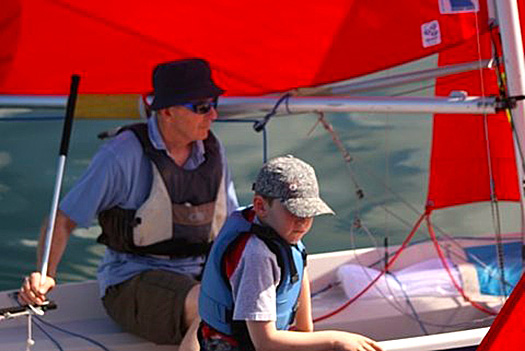
Bryan Amstrong of Sligo on the helm for a Mirror race
Also on board was one of the men from the barricades, Bryan Armstrong of Sligo. His background in a relatively remotely-located club which nevertheless has a long and distinguished sailing history made him uniquely qualified to voice the concerns of the grass roots. And we have to remember that all these people were giving voluntarily and generously of their time to this project in a period when Irish life was largely a matter of just getting through each day, while staying economically afloat was something of an achievement.
Primarily, the Review Group's function was to analyse the Association work on behalf of ordinary club sailors, as it was agreed that the Olympic and High Performance Divisions of the ISA's activities – which receive direct Sports Council grants – were in effect functioning as a different entity.
The Strategic Review Group was still work in progress when the ISA acquired a new President in David Lovegrove in March 2014, but by August the SRG published proposals which led to the setting up of a more formal body, the Planning Group. If this seems like a case of kicking the can down the road, it was anything but - these were people in a hurry, they'd got through the first stage of analysing areas where action was required, now they had to be more structured in coming up with clearcut ideas and concrete proposals.
This new Planning Group, which went into action in early Autumn 2014, was chaired by Neil Murphy, and its members included ISA President David Lovegrove, ISA Board Member Brian Craig, Ruth Ennis, Peter Redden, Sean Craig, and ISA CEO Harry Hermon, with noted Dun Laoghaire events administrator Ciara Dowling to provide administrative support.
They had their draft plan ready by mid-December 2014, and on January 21st 2015 Neil Murphy and his group publicly unveiled their analysis and proposals for the first time at a well-attended and very representative meeting in the Royal St George YC in Dun Laoghaire.
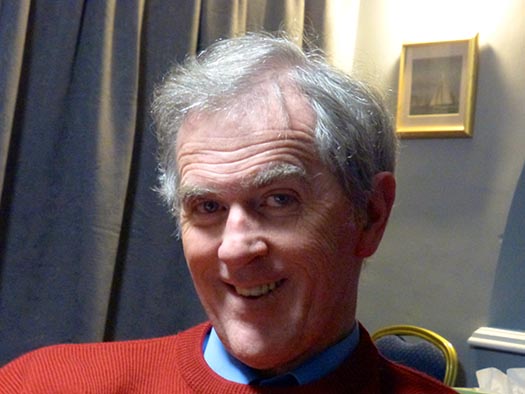 Neil Murphy is a former ISA President who, in addition to extensive experience as a Race Officer, is a typical club sailor, racing a Puppeteer 22 out of Howth. Photo: W M Nixon
Neil Murphy is a former ISA President who, in addition to extensive experience as a Race Officer, is a typical club sailor, racing a Puppeteer 22 out of Howth. Photo: W M Nixon
While those involved in setting the ISA on a healthier course are mostly working on a voluntary basis, it has to be said that the PowerPoint presentation and the printed material was of the highest professional class. In fact, it was much better than many professional shows I've been to, and the level of thought which went into a wide range of questions from the floor answered by Neil Murphy, Brian Craig and David Lovegrove generated a growing level of goodwill which concluded with Norman Lee voicing his congratulations and good wishes for this continuing process in which he and Bryan Armstrong had played such a key role.
So now we move on to the next stage – taking the ideas to the rest of the country. Doubtless you'll have noted the double meaning in titling this piece 'Just Who Do The ISA Think They Are?' In a first interpretation, that question is the one for which, let's hope, we are all now involved in working together in providing and implementing a satisfactory answer.
But equally, as the ISA Road Show gets out of Dublin to take this excellent presentation to a public meeting in Cork next week (it's in the Rochestown Park Hotel on Tuesday, Feb 17th, 7.0 pm to 9.0 pm) and then Galway the week after (Galway Bay Sailing Club, Tuesday 24th February 7.0 pm to 9.0pm), they'll be taking themselves into areas where experience of sailing administration long pre-dates the establishment of organised sailing on Dublin Bay.
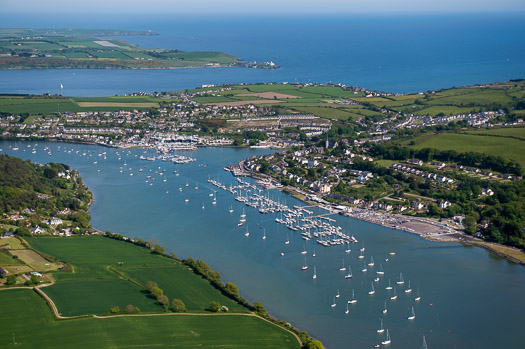 Crosshaven in the summer time. When we look at the natural advantages to be found here, it's little wonder that structured recreational sailing on Cork Harbour long-pre-dated any organised sport on Dublin Bay. Photo: Robert Bateman
Crosshaven in the summer time. When we look at the natural advantages to be found here, it's little wonder that structured recreational sailing on Cork Harbour long-pre-dated any organised sport on Dublin Bay. Photo: Robert Bateman
So you might well ask just just who do they think they are, these people from Dublin, going down to Cork to try to tell them how sailing should be organised? The nerve of them, doing it in a place where they've had organised sailing since 1720, and where the two biggest clubs – the Royal Cork and Kinsale – are both mighty establishments of international sailing repute which would remain so even were the ISA to disappear overnight in a puff of smoke...
And as for going west along the road to Galway, that will take them through Athlone where the Lough Ree Yacht Club dates back to 1770, while on the west coast the Royal Western of Ireland YC at Kilrush traces its origins back to 1828. Equally, further north along the Atlantic coast Sligo YC dates back to 1821, and in Lough Erne the club began in 1820. Yet the first club on Dublin Bay, the Royal Irish, only began as recently as 1831, and even then it barely hung in and had to be revived in 1846, with the pace being set in the meantime by the Royal St George YC, founded 1838.

Kinsale is another harbour which seems to have been designed with sailing primarily in mind. Photo: Kevin Dwyer/courtesy ICC

Kilrush on the Shannon Estuary had a club in being before there were any sailing institutions on Dublin Bay. Photo: W M Nixon
So in terms of sailing administration history, Dublin and Dun Laoghaire are only Johnny-come-lately places by comparison with just about everywhere else in Ireland. Yet thanks to the inevitable dominance of economic development, population growth and the strengthening centres of political power, we now find that sailing administration and decisions of national import are emanating from a place that, in terms of natural sailing advantages, lags far behind the rest of the country.
Oh for sure, Dun Laoghaire Harbour is a fabulous artificial amenity, and the advent of the new marina at Greystones has already been seized upon as greatly increasing the "cruising" options of Dublin Bay. But let's face it, Dublin Bay is really only good for racing, specific day sailing and training, whereas Cork Harbour and Kinsale provide such a variety of opportunities for interesting race courses, mini-cruises with multiple destinations and what have you, that in effect they're not just in a different part of the country – they're a different country altogether.

Dun Laoghaire is a totally artificial facility, and sailing options on Dublin Bay are limited. But it's inescapable that this is the primary point of leisure access to the sea for Ireland's largest and most affluent population. Photo: Kevin Dwyer/courtesy ICC
All of which adds to the difficulties of creating a meaningful national authority with which every sailing person can identify.
This business of Dublin v The Rest is not unique to sailing, of course, but when you have a specialist sport with multiple sub-branches of activity, the problem is exacerbated.
So please bear this in mind if you take yourself along to the meetings in Cork or Galway during the next ten days. This really is a genuine attempt to base the ISA within the sailing community at an everyday level of usefulness to all, with scope for growth while enhancing existing structures, and input from the sailing community at this stage will help in developing the ideas and initiatives proposed.
While the draft ISA Strategic Plan 2015-2020 very definitely puts the emphasis back on to the need for healthy well-run clubs as the basis for the sport, there was initially a feeling at the meeting on January 21st that the new-look ISA is not supportive of commercial sailing schools. In fact, what the new-look ISA hopes to do is encourage training schemes within clubs, while at the same time supporting commercial sailing schools where the demand is such that no club could realistically cope while maintaining its essential club ethos.
Going into this in more detail in a personal meeting this week with Neil Murphy, who is a Chartered Quantity Surveyor, we talked around the fact that a thriving club scene is central to the spirit of Irish sailing, and he was musing on the success of Sutton Dinghy Club where Hugh Gill heads up what is in effect a commercial sailing school within a club setting.
In fact, what Murphy would hope to see emerge at larger population centres is sailing's equivalent of the public golf course. Anyone who has used a public golf course will be aware that the proprietors are usually mustard keen to encourage the formation of a "club" within their customer base, and there is no reason why this shouldn't eventually take root in Irish sailing, providing access to sailing at a fraction of the cost of joining an established club.
It's not something which can realistically be objected to by established clubs trying to protect their own membership, as the people who would use a "public sailing club" would be those who simply couldn't afford to go sailing at all in the current traditional club setup.
Nevertheless support for the established club setup is central to the new Strategic Plan, and the provision of Regional Development Officers to serve clubs directly is very much to the fore in the new thinking. But in looking over the figures published with the report, it's good to note that the ISA works with no less than 80 recognised training centres, while an encouraging statistic is that there are now 24 secondary schools in Ireland which include sailing as a regular part of their curriculum. Admittedly it's a long way from the French setup where every schoolkid is entitled by law to one week of sailing and one week of skiing per year, but in a country where an aversion to being on the water used to be thought inevitable, it's a step in the right direction.
All these considerations of inexpensive sailing are a whole world away from the stories of recent weeks and days about the ISA's High Performance Division seeking a fund-raising executive who will be tasked with finding €2.75 million per annum through philanthropic and other donations in order to help the funding of top level campaigns which we're not allowed to call Olympic campaigns, as apparently that is copyrighted by the Olympic Council, so we call them High Performance instead.
But apparently Government departments aren't restricted by this limitation on the use of the word Olympic, for it was bandied about like nobody's business in this week's news that the government is spending mightily through the Sports Council, with sailing being number three in all Ireland in terms of current Sports Council funding, with a total tag of €1,289,900.
Of course it's not all for specifically Olympic sailing, but it covers 103 sailors from Optimists to the Olympics. Which is fine and dandy for those who are mad keen to race at the highest level, but most sailors in Ireland are much more interested in performing well within their chosen area and boat class, but with sailing being just part of a reasonably civilised and well-balanced life.
And as became evident at the meeting on January 21st, there's an increasing number of people who feel that sailing needs to realise that there's a sizeable population out there of folk who'd like to go sailing, but don't feel the almost religious vocation to own a boat.
With the rapid expansion of sunshine sailing holidays with boats and equipment readily available for hire at the destination, there's a strong feeling there's a real need for more of this in Ireland, even if we can't guarantee the sunshine. The suggestion brings us back to both the "public sailing club" concept, and the growing realisation by established clubs that they have to reach out to potential members by having boats available for sailing on a trial basis.

The Affordable Sailing Team – Norman Lee (right) with his brother Ken beside their campervan at last year's GP 14 Worlds at East Down YC on Strangford Lough. Photo: W M Nixon
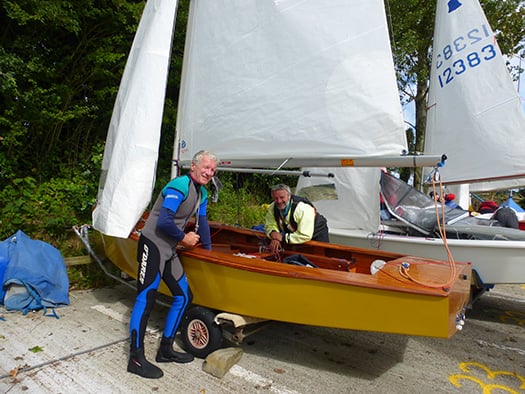
With their own very high can-do standards of boat maintenance, Norman and Ken Lee can keep their GP 14 in the competitive frame. Photo: W M Nixon
That said, the need to own one's own boat and tune and tinker with her to your heart's content is what sailing is all about for many of us, and Norman Lee is a classic case in point for this approach. He claims that his sailing costs him just €600 per year, though that of course is after he has paid for his well-tuned GP14, and he has long since written off the cost of the vintage camper-van which is home to the Lee Equipe when they hit the campaign trail.
Nevertheless the entire setup has to be outstandingly good value, and doing it in such economical style is part of the fun of it all. So when someone with Norman Lee's approach to sailing is prepared to get up at the big ISA public meeting in Dun Laoghaire and congratulate the team who have been working on the reforms which he and Bryan Armstrong set in train, then that is approval of a high order.
And as for just who or what is the ISA, can we maybe agree that ideally we all are the ISA, every last one of us who goes sailing or is even just interested in the sport, and it's up to us to keep it in line and encourage it to identify with and serve the ordinary sailor every bit as much as the high-flyer.

Private pleasure.....the 2014 GP 14 Worlds at East Down YC is about as high as many Irish sailors would expect or want to aim, and many are content with much lower-key regular club sailing. Photo: W M Nixon
Excessive Speed, Poor Visibility To Blame For Lough Ree RIB Collision - MCIB Report
#MCIB - Excessive speed and poor visibility were the biggest contributing factors in a RIB crash incident on Lough Ree two years ago, according to accident investigators.
One passenger sustained head injuries when the RIB, with a helmsman and three passengers on board, collided with the centre support polars of the Athlone Railway Bridge, close to the Westmeath town's marina, on the evening of 14 July 2012.
Though the injured passenger required a transfer to Beaumont Hospital in Dublin after losing consciousness, all four people on the RIB were later released from hospital.
The RIB itself, however, was damaged beyond repair, says the Marine Casualty Investigation Board (MCIB) report into the incident, which also detailed that the nature of the damage caused was consistent with a RIB accelerating at a speed greater than 15 knots.
This was in spite of speed limits of the Shannon Navigation set at no more than 5kmph within 200m of any bridge, quay, jetty or wharf, when in a harbour area or within 100 of any moored vessel.
It was also determined that was the collision occurred around sunset, "it is likely that the light conditions would not have been good".
The full MCIB report into the Lough Ree incident is available to download below.
Fireball Nationals Report: How McCartin & Kinsella Clinched The Title
#Fireball - As previously reported on Afloat.ie, Royal St George pair Barry McCartin and Conor Kinsella were triumphant at the Irish Fireball Nationals on Lough Ree yesterday (14 September), needing two win only one of two races sailed on the day to claim the title after a dominant weekend. Below, Cormac Bradley gives us an extended report on all the action over the three days' sailing:
The 2014 Irish Fireball Nationals were sailed at Lough Ree Yacht Club this past Friday, Saturday and Sunday, involving nine races in very challenging conditions – not heavy duty sailing but light conditions that on a freshwater lake made picking the right way to go all the more challenging.
The forecast for the weekend was for lightish winds but on Friday we started proceedings in slightly more than 12 knots, though race officer John Leech was not convinced that the wind would stay long enough at that strength to warrant flying the 'pumping flag'. He was correct in his assumption as the wind progressively dropped off as the afternoon wore on. However, we did get three good races in.
On Saturday we were joined by the Wayfarers who were sailing a two-day Nationals with six races. On arrival at the club, what wind there was appeared to be coming from the opposite direction and was very fickle. Nevertheless, it was better than we had been expecting so both fleets took to the water for what turned out to be a long sail to the start area where we were greeted – understandably – with a postponement flag.
Four races were sailed on Saturday, the last of which saw the leading bunch stay in what breeze there was all the way round. The middle and back of the fleet weren’t so lucky in that their wind supply was temporarily reduced. This led to a very strung out fleet.
By Saturday evening, the die seemed to be cast as far as the overall 1-2-3 was concerned and had this been a betting event, the bookies’ money would have been safe. The predicted and usual suspects were at the head of the fleet – McCartin and Kinsella, Butler and Oram and Rumball and Bradley (Finn). McCartin had a four-point cushion on Butler, who had a point on Rumball, so the real action on Sunday would be between Butler and Rumball for the secondary placings on the podium. Could/would McCartin stuff it up?
Sunday appeared to give better breeze initially after a one-hour postponement posted the evening before – John Leech using his knowledge of the venue to very good effect. Yes there was trapezing to be had but it was an on-and-off exercise.
Race 8 got off cleanly with McCartin initially further back than he would have wanted but ultimately coming back to take the race win and therefore the regatta. Rumball finished second and with McGrotty getting into third to Butler’s fourth, Rumball now had the one-point advantage.
An impeccably behaved fleet then went 'off the radar' for the final race of the regatta with three attempts at a start before we got away. First the 'I' flag came out, then we had two starts under the 'U' flag regime. The suggestion post the race was that the leading three were involved in mind games, providing great entertainment for the committee boat crew.
Having secured the overall win, McCartin donned the trapeze harness to allow Kinsella an opportunity to drive. However, by the second leeward mark, after a modest transgression of the 'water at the mark' rule, they retired ashore for an early celebratory shower.
On the water, Rumball and Bradley stormed away to a very convincing win while Neil Colin and Margaret Casey 'slummed it with the upper echelons' by recording a second place, following another 'trek' to the right hand side of the course. (Their first had resulted in a win on the Saturday.) Butler and Oram finished third.
This was the penultimate event of the Irish Fireball Regatta season. In three weeks’ time we sail our final event of the season, the Leinsters out of the National Yacht Club, sharing with the Flying Fifteens. The AGM of the Class will take place on the Saturday night of this event.
The weekend before, on Saturday 27 September, Dublin Bay Sailing Club celebrates its 130th year of operation with a dinner in the National Yacht Club. As a member Class of DBSC, Irish Fireballers are encouraged to attend.
Irish Fireball Nationals 2014
Overall Results:
1 Barry McCartin & Conor Kinsella (RStGYC; IRL 15114)
2 Kenneth Rumball & Finn Bradley (INSC; IRL 15058)
3 Noel Butler & Stephen Oram (NYC/DMYC; IRL 15061)
Silver Fleet:
1 Mary Chambers & Brenda McGuire (DMYC; IRL 14865)
2 Pat O’Neill & Tiarnan Dickson (CYBC/LRYC; IRL 14849)
Classic Trophy:
Owen Clarkin & Tim (CYBC: IRL 14244)
McCartin & Kinsella Lead at Fireball Nationals on Lough Ree
#fireball – Four races were sailed at the Irish Fireball Nationals on Lough Ree today in light conditions and as usual when it goes light, not to everyone's satisfaction writes Cormac Bradley.
The day's honours go to Kenneth Rumball & Finn Bradley (15058) with a 3, 3, 1, 1 day. This leaves them in third place overall, a point behind Noel Butler & Stephen Oram (15061) who had a 5, 2, 2, 2 day. In the front of the fleet are Barry McCartin & Conor Kinsella (15114) who were a little off the pace, by their standards, and scored a 7, 1, 3, 3. With the first discard kicking in their points cushion is 4.
For the rest of the fleet the most encouraging result of the day was the win in the first race by Neil Colin & Margaret Casey (14775). They hit the biggest right hand corner I have seen for some time and rounded the top mark with a huge lead that they extended during the race.
The perennial debate of sailing four races to try and get the full suite completed tomorrow raised its head again. Do you persist with races in light conditions or sail three and run out of time tomorrow to get in the third race of the day. Who'd be a Race Officer?
In fourth place overall is Team Clancy, Conor & James (14807) who scored 2, 5, 7, 4 today. This gives them a 3 point cushion on Niall McGrotty & Neil Cramer (14938) who, as usual, are sailing very consistently (3, 7, 2, 4, 4, 5). There is then a huge 14 point jump to 6th overall where we find Colin & Casey (37pts). 7th place is filled by the father and son combination of Michael & James Murphy (14908) (38pts), 8th goes to the all-lady team of Louise McKenna & Hermine O'Keeffe (45pts), 9th to Louis Smyth & Cormac Bradley (15007) (51pts) and the top ten is closed out by Mick Creighton & Hugh Johnson (14698) (55pts).
Sunday will see two races attempted to give the Fireballs a 9-race series and the prospect of a second discard.
Cormac.
#RNLI - A busy weekend for the volunteer crew with Lough Ree RNLI began on Friday evening 25 July when the lifeboat launched at 6.30pm for a cruiser with engine problems near marker no 9 north of the Quaker Island.
When the lifeboat arrived on scene it found the 34-foot cruiser was at anchor. There were two adults on board and the engine had overheated.
The casualty vessel was towed to Ballyleague and the lifeboat was back on station and ready for service at 8.40pm.
Lough Ree's lifeboat next launched at 7.22am on Saturday morning for a cruiser aground near the Black Islands.
On arriving on scene the lifeboat crew found two adults and four children on board. They were taken on board the lifeboat and dropped off at Quigley's Marina, while a rescue boat later arrived on scene to take care of the cruiser.
The lifeboat crew had just left the station when another call out was received at 9.52am for a cruiser aground off Inch McDermott.
There were six people on board the cruiser, which was eased off the rocks by the lifeboat. The cruiser was then able to proceed under her own power.
At 6.55pm the same day, a callout was received for a large cruiser aground on the Hexagon Shoal with three adults and three children on board.
One female adult and the three children were transferred to the Lough Ree Yacht Club safety RIB, which had been standing by the casualty, and taken to Hudson Bay.
The cruiser was found to be taking water and the lifeboat returned to base to get pumping equipment. The casualty was pumped and towed to Quigley's Marina. The lifeboat was back on station and on standby at 8.50pm.
Lough Ree RNLI lifeboat operations manager Damien Delaney said of the busy weekend: "The recent spell of good weather has brought large numbers of people to the water, many for the first time in years, and this, coupled with the low levels in the river and lake, makes extra attention to the markers and navigation channels necessary."
All this activity comes in advance of the news that the current lifeboat on station at Lough Ree, Dorothy Mary B728, which has been in service since the station began operations over two years ago, is to be replaced.
Dorothy Mary was commissioned in 1996 and has now reached her retirement age. She will be leaving the station this coming week.
Her replacement is to be the Eric Rowse B772, which was commissioned in 2000. She previously served at the St Catherine station in Jersey from 2001 to 2010, when she joined the reserve fleet.
She is the same class of lifeboat as Dorothy Mary, an Atlantic 75, and is due to arrive in the coming days.
#RNLI - Lough Ree RNLI aided 10 people in two separate callouts over the weekend.
The first call came just before 7pm on Saturday (12 July) following a report that two craft vessels had ran aground on the east shore of Inch McDermott. The volunteer crew launched their inshore lifeboat within minutes at 7.06pm.
At the scene, the crew discovered that a 30ft cruiser with two adults on board has suffered engine problems and had drifted ashore.
Meanwhile, a passing 80ft barge with four adults on board that had attempted to give assistance went aground herself.
The lifeboat eased the cruiser off the rocks and gave her into the care of a passing cruiser that had stopped to provide any assistance, before towing the barge back into deeper water.
Thankfully the barge had not suffered any damage and was able to tow the cruiser to Ballyleague. The lifeboat crew extended thanks to the crew of the cruiser Enchantress for their assistance.
The lifeboat crew was called upon for a second time at 4.42pm on Sunday afternoon (13 July) when a cruiser ran aground in the same area.
On scene a 33ft cruiser had grounded with four adults on board. The craft was eased back into deeper water and, after checking for damage, she was able to proceed on her journey.
Lough Ree Lifeboat Assists Seven In Two Weekend Callouts
#Lifeboats - Lough Ree RNLI assisted seven people whose vessels got into difficulty in two separate callouts over the weekend.
The volunteer crew was first requested to launch their inshore lifeboat at 6.20pm on Saturday 5 July following a report that a cruiser was experiencing engine problems off Goat Island.
- The crew responded and went to the assistance of three people on board the 30ft craft. The lifeboat towed the casualty to Ballyleague Marina, returning at 9.20pm.
The lifeboat had a second callout on Sunday 6 July at 6.57pm, this time to assist a yacht with a failed engine off the north end of Nun's Island.
The lifeboat launched at 7.08pm and towed the craft to Hodson Bay. There were two adults and two children on board.
Meanwhile, Lough Ree RNLI recently held its open day at the lifeboat station, during which it welcomed Junior Cert student Liam Chartan from Athlone Community College.
Chartan had been given a project for his exams based on a theme entitled 'My Inspiration' and chose the RNLI, and Lough Ree Lifeboat Station, in particular, as his inspiration – as he lives only a ‘shout’ away from the station and has been inspired by the crew's activities since they commenced two years ago.
Chartan designed his project around a miniature replica of the lifeboat, the Dorothy Mary, and a pedestal with the instantly recognisable RNLI motif.
"When Liam returns from his holidays we hope to have him back to the station to observe a full training exercise," said Liam Sherringham, Lough Ree RNLI volunteer lifeboat press officer.
"We hope he is surely headed for a volunteer crew role in the future, and we wish him well with his exam results."



























